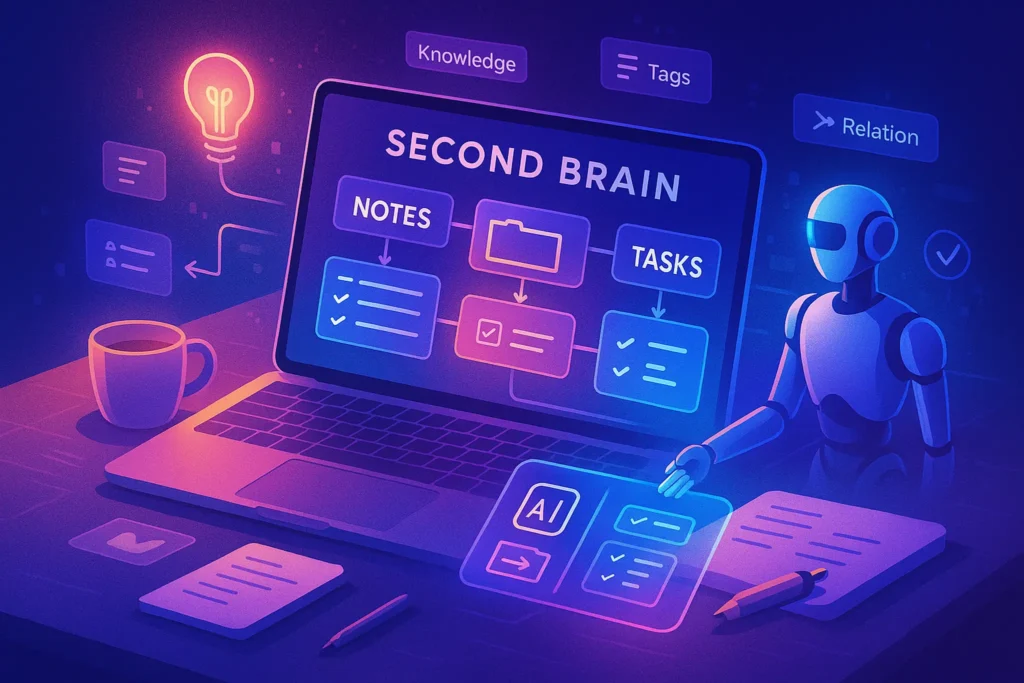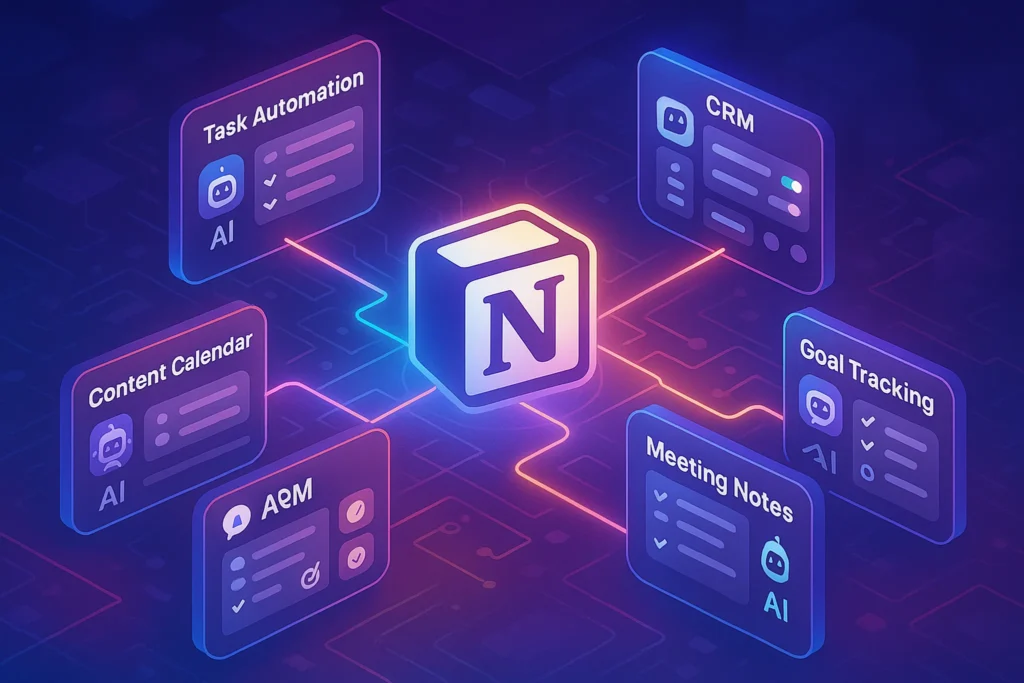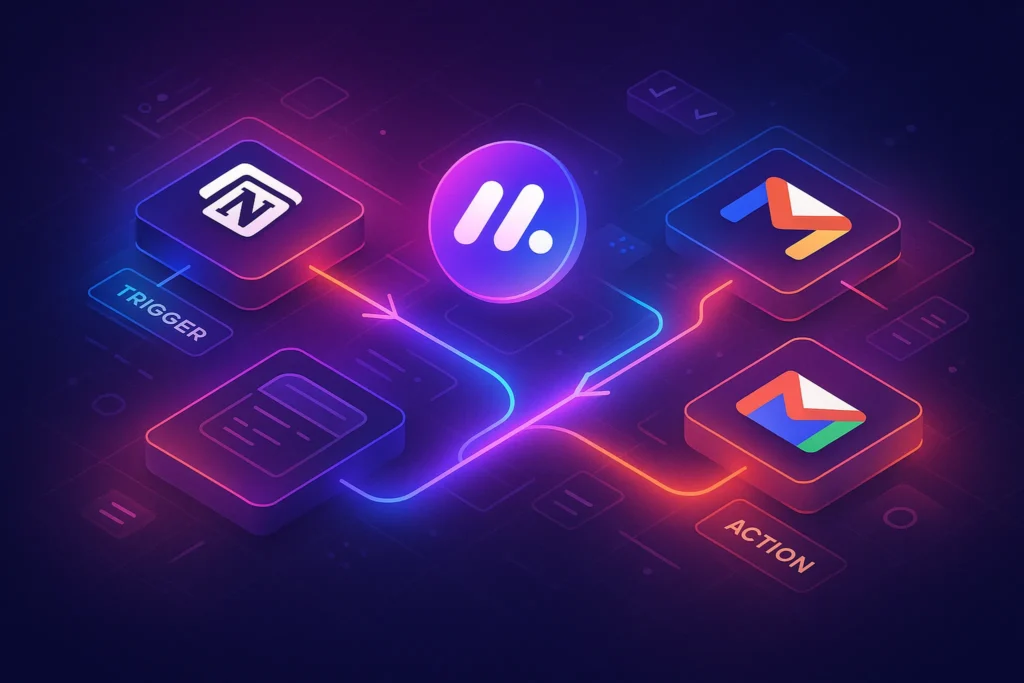-This post may contain affiliate links. If you click on one and make a purchase, I may earn a small commission at no extra cost to you.-
🧭 Introduction
We all face it: ideas bounce around our head or get lost in endlessly nested folders. The Second Brain approach liberates your mind by giving you a trusted digital system. Instead of “I’ll remember this,” you quickly capture it, organize it, and retrieve it when it’s needed—whether you’re drafting an article, building a project, or planning content. This guide gives you a step-by-step system—capture, organize, distill, and create—using powerful tools like Notion and Evernote. You’ll learn how knowledge becomes actionable, lightweight, and deeply useful.
Choosing the right tool to build your Second Brain isn’t always straightforward. If you’re debating between two of the most popular options—Notion and Evernote—you’ll want to check out our head-to-head comparison of Notion vs. Evernote. It breaks down their features, strengths, and ideal use cases to help you decide which platform best supports your long-term digital organization.
🧠 What Is a “Second Brain” and Why It Matters
A Second Brain isn’t just another note system—it’s a life‑organizer that externalizes memory and ideas so your mind can focus on creativity, not retrieval. Instead of the constant mental loop of “where did I save that?”, everything you record goes directly into a trusted digital space. When you later need information, it’s there—tagged, linked, ready. This means no more cognitive clutter. Instead of your brain functioning like a stressed-out browser with 50 open tabs, it becomes a laser-focused machine—ready to apply knowledge, develop ideas, or build projects without mental bureaucracy holding you back.
📦 The Core Principles—Capture, Organize, Distill, Express
✍️ Capture effortlessly
Capture before clarity fades: quotes, ideas, articles, voice memos, screenshots. Use Notion’s Web Clipper, Evernote’s email-to-note, or mobile quick-add forms. Think of this step as your cognitive safety net—you’ll never worry about forgetting again.
🗂️ Organize with intention
Captured notes land in your inbox. Here, consistent tagging—by topic, project, format—creates structure. Notion’s database linking turns notes into living text, and in Evernote, notebooks and tags cleanly group ideas. Your goal is instant discoverability, seconds for retrieval instead of minutes.
✂️ Distill into insight
Raw notes aren’t enough. Each week, process your inbox—summarize key ideas, convert corners of clutter into distilled wisdom. Maybe turn a book highlight into a journal prompt or an idea into a task. Notion can have a “#to-process” filter; Evernote’s “action tag” quickly separates reference material from next steps.
🧩 Express through creation
The final step: creating value. Articles, projects, presentations—your Second Brain fuels them. The designs, drafts, and decision summaries come naturally, not from blank pages. All the raw material is already digitized and organized into meaningful structure.
🛠️ Choosing the Right Tool: Notion, Evernote, and Beyond
Notion
If you prize structure and versatility, Notion is gold. You can build custom databases for meeting notes, book highlights, content ideas, or research archives—and link them together so related info appears contextually when you need it. For example, a meeting note about social launch strategies can tag directly into your personal CRM, connect to your content calendar (like in Monday Content Planning), and sit beside an article idea you clipped last month. It becomes your all-in-one knowledge platform.
Evernote
When speed of capture is paramount—say, you’re on the go—Evernote shines. With minimal setup, you can email, clip, scan, or voice-to-text, and Evernote automatically OCRs images and organizes your input. Within seconds, that research snippet or screenshot becomes findable. Its simplicity is deceptive but powerful—perfect for those who want a light system that just works.
Other Tools (Obsidian, Roam)
Prefer a more visual or networked knowledge approach? Obsidian offers offline Markdown editing and graph visualizations that let you explore how your ideas interconnect. Roam Research puts backlinks at the heart of note-taking—letting you discover hidden relationships between topics. Use them if your creativity thrives on seeing how every note weaves into a bigger tapestry.
🛠️ Tool Comparison—Notion vs. Evernote vs. Others
📓 Notion
Block-based building makes Notion a modular powerhouse. You can combine relational databases, nested pages, kanban boards, and rich embeds. For knowledge workers, it’s a single command center: meeting notes, personal CRM, content planning dashboards—fully linkable and shareable. It connects perfectly when adding notes to How to Build a Personal CRM System Using Notion or managing your editorial calendar from Monday Content Planning.
📚 Evernote
If speed and lightweight capture are key, Evernote wins. It works with email forwarding, image OCR, and web clipping in one click. The notebook/tag combination means less setup—faster onboarding, faster capture. Great as your reference library or searchable archive.
⚙️ Alternatives like Obsidian/Roam
If you prefer Markdown-based writing or networked note maps, tools like Obsidian or Roam shine. Roam’s backlinking supports non-linear thinking, while Obsidian’s local storage and plugin flexibility offer privacy and customization.
🔁 Workflow Blueprint—A Week in Your Second Brain
Imagine Monday morning: you open your workspace and see a growing collection of raw materials from the previous week—clipped articles, meeting thoughts, random voice memos. You spend 30 minutes distilling: adding tags, connecting notes to relevant projects, and pulling out key quotes into your weekly insights page.
By midweek, your Second Brain is working behind the scenes. When you draft content for Monday Content Planning or flesh out a follow-up message to a contact in your Personal CRM, relevant highlights and background data are already there—no searching required.
On Friday, you reflect. You review tags marked #refine or #archive, pulling out long-term goals or trends. You clean up duplicates and refresh your dashboard for the following week. On Sunday evening, you casually scan the entire Brain—ideas that felt peripheral now spark possibilities, and your system feels energized, not buried.
-
Monday: During a 30-minute capture session, gather last week’s highlights, clip articles, voice-record interview thoughts.
-
Tuesday: Process inbox—tag, summarize, and link each note into the right project or reference area.
-
Wednesday: Pull insight—turn a week’s distilled notes into a content outline, journal post, or brainstorm table.
-
Thursday: Build—use your system for content strategy, research proposals, or planning tasks.
-
Friday: Reflect—review what gained energy this week. Archive or purge irrelevant material.
-
Sunday: Prep next week with rough outlines from your Brain, ensuring momentum.
🔗 Integrating With Your Ongoing Systems
All your workflows don’t have to live in isolation. If you’re already using Best AI Note‑Taking Apps for Students, you might be capturing research highlights or lecture clips—now scale that into capturing meeting notes, article snippets, brainstorming ideas, or coaching frameworks. If you’re managing your network in Notion through How to Build a Personal CRM System, extend it by linking each contact with relevant meeting notes, shared articles, or follow-up tasks—all captured in your Brain. And if your publication process runs through Monday Content Planning, your note system becomes the source: idea row → draft template → final article—seamlessly connected.
-
If you’ve explored Best AI Note‑Taking Apps for Students, you already value capturing fast. Clone that into larger productivity formats with Notion—you’ll build beyond study notes.
-
You already manage contacts and pipeline with How to Build a Personal CRM System Using Notion—now you can link important meeting notes or research directly to your CRM pages.
-
And if you juggle editorial planning in Monday Content Planning, your Second Brain becomes the source of truth—article prompts, quotes, drafts, and links flow easily from your personal wiki into your calendar and content tasks.
❌ Common Mistakes When Building a Second Brain
While the idea of a Second Brain is simple, many fall into traps that silently sabotage their system. Here’s what to watch for:
📥 Mistake 1: Capturing Everything Without Purpose
Many new users fall into “digital hoarding”—saving every quote, thought, or screenshot. But without filters, your Second Brain becomes a messy dump. Ask yourself: Will I use this later? Is it actionable or reference-worthy? Keep your capture inbox open, but process intentionally.
🧷 Mistake 2: Over-Structuring Too Early
Before understanding your real workflow, it’s tempting to build dozens of folders, databases, and tags. But this premature optimization leads to rigidness. Start small: a few core areas (e.g., Notes, Projects, Archive) and let your needs shape the architecture over time.
🧹 Mistake 3: Not Reviewing Your Notes
A Second Brain only works if you revisit and refine what you’ve stored. Skipping your weekly review or never summarizing key insights creates digital noise. Make it a habit: clean, distill, re-tag—otherwise, your Brain becomes passive, not productive.
⚠️ Mistake 4: Mixing “Thinking” With “Storing”
Use distinct spaces for different purposes. Thinking space (e.g., draft boards, content pipelines) should be active and evolving. Storing space (e.g., books read, research logs) should be clean and browsable. Blurring these functions confuses your system and hinders creative flow.
💬 Mistake 5: Forgetting the “Why”
Tools are exciting—but a Second Brain is only effective if aligned with your goals. Are you building it to write more? Make better decisions? Learn faster? Keeping your purpose visible (in a dashboard or daily journal) ensures the system serves you—not the other way around.
🤖 Bonus: How AI Can Enhance Your Second Brain
In 2025, AI doesn’t just support knowledge management—it transforms it. By integrating intelligent tools into your Second Brain, you shift from “manual note-taking” to “accelerated synthesis and automation.”
✨ Smart Summarization
AI tools like Mem AI, Notion AI, or Reflect can automatically distill long meeting notes, articles, or transcriptions into concise, readable summaries. This saves you hours and lets you focus on insight instead of data wrangling.
🧠 Intelligent Tagging & Linking
Some Second Brain tools now auto-suggest tags and related content as you type. This improves your ability to cross-reference ideas you didn’t know were connected. It’s how “random” inspiration becomes structured knowledge.
📆 Actionable Workflows
AI can recommend next steps based on captured input. For example, after summarizing a brainstorming session, your workspace may prompt a follow-up task list, connect to your content calendar, or suggest meeting templates.
🔄 Dynamic Content Refresh
Tools like Rewind or Mem.ai continuously monitor your note archive and bring forward forgotten gems—like resurfacing a note from 2022 that matches a current project keyword. Your Brain becomes alive, constantly curating itself.
✍️ Faster Content Creation
Once your ideas are tagged, connected, and summarized, AI writing assistants help you spin out content. Drafts, email outlines, knowledge-sharing documents—your Second Brain becomes a publishing engine.
These AI upgrades don’t replace thinking—they remove friction, automate the boring parts, and help you spend time on synthesis, strategy, and creativity.
🧩 Keep It Fresh—Maintenance Matters
A Second Brain is a living system—it requires seasonal attention. Treat it like a garden: prune dead tags, archive old projects, reorganize categories for clarity. Monthly reviews help you reconnect with dormant ideas and decide what still matters. Tools like Notion can show you your most-used pages—use that data to surface big themes or underused areas. Regular maintenance keeps your system agile and keeps your mind from being burdened by digital debris.
Even Second Brains need care. Every two weeks, archive whatever hasn’t been referenced. Rename tags to keep them consistent. Delete duplicates. Your system should feel alive—not an endless pile. Add sorting habits—like sorting by least-used tags—to see old but possibly useful notes.
🧠 Nerd Verdict
A Second Brain is your creative partner. It removes friction between idea and action, between thought and project. Instead of “I need to remember that later,” you immediately capture, commit, clarify, and continue. You’ll spend less mental energy juggling tasks and more building the outputs you want. With a lightweight routine and a flexible tool, productivity becomes personal, powered, and persistent.
❓ FAQ
Q: Is this overkill for casual users?
A: Not at all. Even a handful of templates—like “Readings,” “Project Notes,” and a weekly inbox—create structure without overwhelm. Start small, grow organically.
Q: How do I choose between Notion and Evernote?
A: If you love flexible design, cross-linked ideas, and drag-drop databases: go Notion. If you want speedy capture and effortless search: go Evernote.
Q: What if I forget to process notes?
A: Use recurring reminders—if your inbox sits for a week, build a “process” checklist or habit-stack it with your Sunday planner. Consistency beats perfection.
💬 Would You Bite?
Which tool are you most excited about—Notion, Evernote, or Obsidian? And what’s the one capture habit you’ll commit to this week—web clipping, voice note, meeting summary?
Let me know below, and I’ll share a tailored template to help you build momentum immediately.👇



